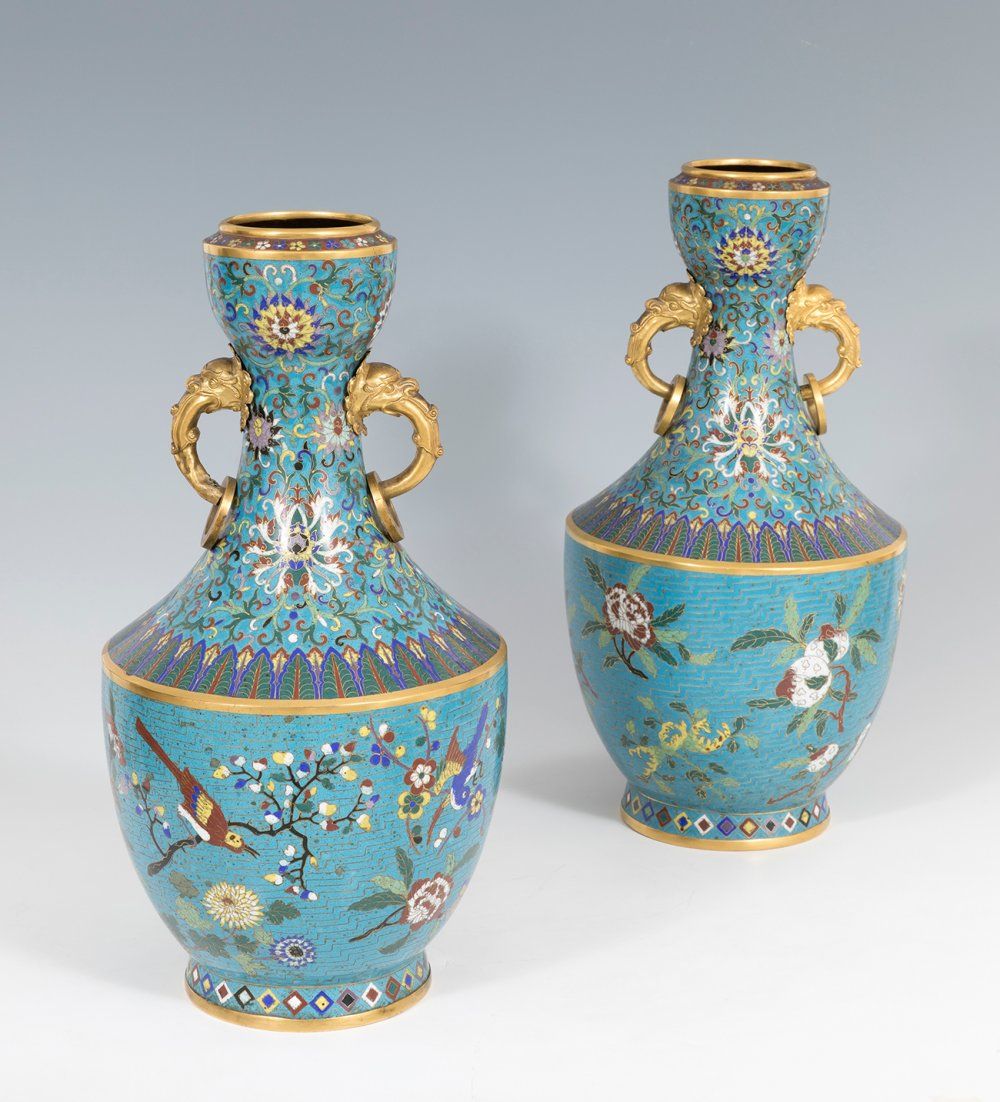Description
Pair of vases; China, Qing Dynasty, 1736- 1796. Bronze and cloisonné enamel. It has slight losses in the enamel and slight integrations. One of the handles is missing. Measurements: 48 x 25 cm (x2). Pair of vases made in bronze and decorated with enamels applied with the cloisonné technique. Both pieces have a similar ornamentation with a round base decorated with a diamond pattern in alternating colors. The deposit of each of the pieces has a blue finish with figurative scenes formed by lotuses, peonies, camellias, magnolias and peach tree branches on which sit long-tailed birds. This bird decoration is called "Shou dai niao" (silk-tailed bird). It is a symbol of longevity. This type of ornamentation was particularly popular during the Ming and Qing dynasties, and its colorfulness was a very appreciated resource in the export market during the 19th century. Returning to the vases, the body is limited with schematic banana leaves that give way to the neck decorated with lotus flower motifs with tendrils in both cases "Chan zhi lian". Each of the pieces has two bronze handles sculpturally conceived, as they represent a dragon, symbol of wisdom, with a bronze ring anchored to each of the handles. Finally, the daub is topped with a small border of flowers and a golden lip. Under the Qing, inherited art forms flourished and innovations occurred on many levels and in many types. High levels of literacy, a successful publishing industry, thriving cities, and Confucian emphasis on cultivation nurtured a lively and creative set of cultural fields. By the late 19th century, the national artistic and cultural worlds had begun to reconcile with the cosmopolitan culture of the West and Japan. The decision to remain within the old forms or to welcome Western models was now a conscious choice rather than an unquestioning acceptance of tradition. Classically trained Confucian scholars. The Qing emperors were generally skilled in poetry and often skilled in painting, and they offered their patronage to Confucian culture.
81
Pair of vases; China, Qing Dynasty, 1736- 1796. Bronze and cloisonné enamel. It has slight losses in the enamel and slight integrations. One of the handles is missing. Measurements: 48 x 25 cm (x2). Pair of vases made in bronze and decorated with enamels applied with the cloisonné technique. Both pieces have a similar ornamentation with a round base decorated with a diamond pattern in alternating colors. The deposit of each of the pieces has a blue finish with figurative scenes formed by lotuses, peonies, camellias, magnolias and peach tree branches on which sit long-tailed birds. This bird decoration is called "Shou dai niao" (silk-tailed bird). It is a symbol of longevity. This type of ornamentation was particularly popular during the Ming and Qing dynasties, and its colorfulness was a very appreciated resource in the export market during the 19th century. Returning to the vases, the body is limited with schematic banana leaves that give way to the neck decorated with lotus flower motifs with tendrils in both cases "Chan zhi lian". Each of the pieces has two bronze handles sculpturally conceived, as they represent a dragon, symbol of wisdom, with a bronze ring anchored to each of the handles. Finally, the daub is topped with a small border of flowers and a golden lip. Under the Qing, inherited art forms flourished and innovations occurred on many levels and in many types. High levels of literacy, a successful publishing industry, thriving cities, and Confucian emphasis on cultivation nurtured a lively and creative set of cultural fields. By the late 19th century, the national artistic and cultural worlds had begun to reconcile with the cosmopolitan culture of the West and Japan. The decision to remain within the old forms or to welcome Western models was now a conscious choice rather than an unquestioning acceptance of tradition. Classically trained Confucian scholars. The Qing emperors were generally skilled in poetry and often skilled in painting, and they offered their patronage to Confucian culture.
You may also like
